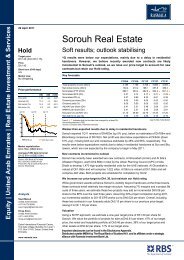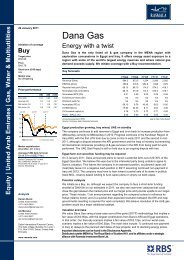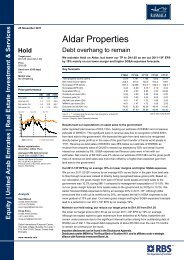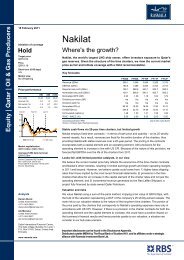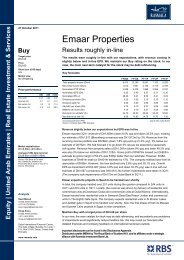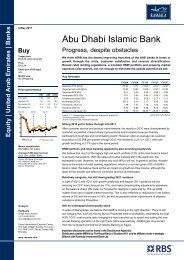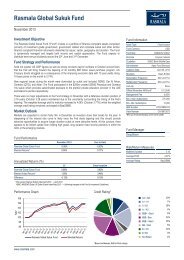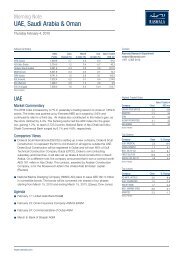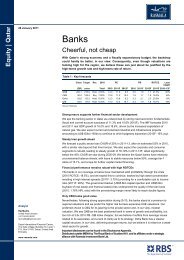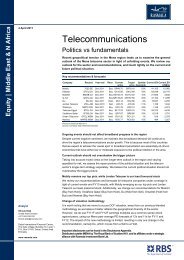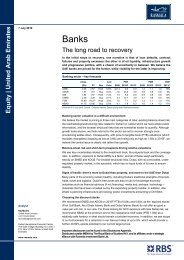Rasmala GCC Fixed Income Fund - Rasmala Investment Bank
Rasmala GCC Fixed Income Fund - Rasmala Investment Bank
Rasmala GCC Fixed Income Fund - Rasmala Investment Bank
You also want an ePaper? Increase the reach of your titles
YUMPU automatically turns print PDFs into web optimized ePapers that Google loves.
The <strong>Fund</strong> <strong>Investment</strong> Process<br />
Selection Criteria<br />
Credit Analysis / Rating Issue Size & Liquidity Interest rate profile Duration and Convexity<br />
Focus on Risk<br />
The <strong>Investment</strong> Manager utilises its expertise in fixed income investing to select the most appropriate securities.<br />
Analysing the underlying Verifying the issue size Selecting the appropriate Modified duration and<br />
credit of the issuer and liquidity interest rate profile convexity<br />
Focus on risk adjusted<br />
return<br />
The investment process<br />
requires a detailed analysis<br />
of the underlying credit risk<br />
of an issuer. The credit<br />
process is multi faceted and<br />
employs a combination of<br />
proprietary credit analysis,<br />
third-party credit intelligence<br />
and external credit rating<br />
reports released by the<br />
major rating agencies.<br />
Secondary market liquidity<br />
impacts directly on the<br />
performance of an actively<br />
managed portfolio. The<br />
investment process therefore<br />
includes an evaluation of the<br />
expected secondary market<br />
liquidity of instruments to be<br />
held in the portfolio, with a<br />
liquidity rating applied. This<br />
liquidity rating is regularly<br />
reviewed and plays an<br />
important part in the asset<br />
allocation process.<br />
A fixed income portfolio is<br />
exposed to both changes in<br />
the absolute level of interest<br />
rates and the shape of the<br />
yield curve. These risks are<br />
continuously monitored and<br />
regularly reviewed to ensure<br />
that the portfolio is<br />
appropriately positioned for<br />
both the prevailing interest<br />
rate environment and any<br />
expected changes.<br />
Modified duration is a broad<br />
measure of the price<br />
sensitivity of bonds or<br />
portfolios to small parallel<br />
shifts in the interest rate<br />
curve. Convexity quantifies<br />
bond or portfolio price<br />
changes due to larger<br />
parallel shifts in the interest<br />
rate environment. Both<br />
measures are employed to<br />
assist in the management of<br />
interest rate sensitivity of the<br />
portfolio.<br />
A matrix of both quantitative<br />
and qualitative factors are<br />
considered when analyzing<br />
potential investments<br />
opportunities. Existing<br />
investments are dynamically<br />
managed to profit from<br />
anticipated changes in the<br />
macro environment,<br />
envisaged shifts in interest<br />
rate curves and expected<br />
improvements or otherwise<br />
in the underlying credit<br />
quality of investments.<br />
Relative value strategies are<br />
also employed to maximize<br />
the risk adjusted return to<br />
investors.<br />
<strong>Rasmala</strong> <strong>GCC</strong> <strong>Fixed</strong> <strong>Income</strong> <strong>Fund</strong><br />
13



